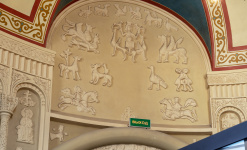Domestic and foreign policy of the Ancient Russian state in the period of feudal division. 12th – first half of the 13th century








Time from the beginning of the 12th century to the Mongol invasion in the 13th century is called the Principality period or period of political fragmentation of Russia. Traditionally the throne was transfer to the eldest in the family, i.e. from brother to brother, and after the death of the last of the brothers to the eldest nephew. Such an order of inheritance was called "rota system" (from the old Slavic family) or "lestva system" (from the old church for ladder). Thus, the Kievan throne was to be held by the Prince, the eldest in the Rurik family. The rest of the Rurik line had to submit to his authority.
The growth of power of separate principalities, personal ambitions were the reasons for princely strife. In 1097, after a fierce struggle for power, the Congress of princes in the city of Lyubech made a crucial decision: "Everyone to keep his patrimony", which meant the possibility to inherit of the father's lands by his son.
A dozen independent principalities and lands ruled by local dynasties made up the Ancient Russian state: Kiev, Chernigov, Rostov-Suzdal (or Vladimir-Suzdal), Smolensk, Tmutarakan, Novgorod and Pskov land, and some others.
Kiev, though still being for some time first among equals was gradually losing its position. Soon other lands caught up and even got ahead of it in their development. During the whole period of the 12th century four major dynasties of Chernihiv, Smolensk, Vladimir-Suzdal and Galicia-Volyn princes actively struggled for the Kievan throne, that gave authority over the rich area and the nominal title of the first Prince in Russia. The only major center that did not form its own prince dynasty was Novgorod, which became a trade feudal Republic, and in which the Prince's power was severely limited by the people's Assembly (Veche): The Prince did not have the right to collect tribute, which allowed the boyars to accumulate considerable wealth in their hands.
The Veche (people’s assembly) that elected Novgorod administration, made decisions on the most important issues of domestic and foreign policy. In fact, the master of the Veche were 300 "golden belts" the major boyars of Novgorod.
The Veche invited the Prince, who was in charge of the army during the military campaigns; his Drouzhina (the Squad) maintained order in the city. He apparently symbolized the unity of Novgorod and the rest of Russia.
In Vladimir-Suzdal Principality was a different type of government.
The rise of the Vladimir-Suzdal Principality begins with the sixth son Vladimir Monomakh – Yuri (1125–1157). For the constant yearning to expand its territory and subdue Kiev, he was nicknamed "Dolgoruky" (LongArmed). Yuri conducted a wide construction of fortified cities on the borders of his Principality. The chronicles for the first time in 1147 mentioned Moscow, built on the site of the confiscated estate of the boyar Kucha.
The might of the Vladimir-Suzdal Princes in the end of 12th – beginning of 13th centuries was so great, that the author of "Word about Igor's regiment" was describing Vsevolod the Big Nest (1176–1212, his nickname had been given to him for a great number of sons): "he can spill the Volga river with oars and scoop the Don river with helmets".
In the middle of the 11th century at the limits of Russia emerged the Polovtsi (Cuman-Kipchak) (the first mention refers to 1055), who, remaining close neighbors, for two centuries were sometimes irreconcilable enemies of Russia, sometimes the allies of Russian princes in their intestine wars.
The main job of the Polovtsian was cattle breeding, that made them move from one place to another. Besides cattle breeding, war and hunting largely determined the economy, social system and life of the Polovtsian people.
Hunting provided the Polovtsi with a considerable amount of food, by organising huge round-up hunts, as a rule, headed by the largest military leaders and aristocrats. Hunting was regarded as the traverse (raid) in the foreign country. People were preparing to it, hunting had developed skills and the art of war. The hunt had an important function of training of military skills of everyone – from the Khan (learned to give orders) to a simple warrior (to act together in the horse ranks).









The rich sculpture and art design of the hall was inspired by the outstanding white stone architecture of ancient Vladimir. Magnificent Dmitrievsky and Assumption Cathedrals served as models for decoration of this hall.
Above one of the portals is placed a copy of a relief "King David on the Throne"; above the other is a scene "The Ascension of Alexander the Great". The relief composition on the wall between the windows depicts Prince Vsevolod the Big Nest (Prince of Vladimir, 1176–1212). Prince is sitting on the throne with his son Dmitry on his knees, surrounded by other sons. The walls of the round hall are decorated with reliefs from the facades of Dmitrievsky (St.Demetrius) Cathedral with images of the Saints, trees, birds and mythical creatures symbolizing the forces of nature.
The painting of the dome vault, painted "towels" on the walls and the mosaic pattern of the floor repeat the ornaments of the unique frescoes of the Assumption Cathedral of Vladimir.





